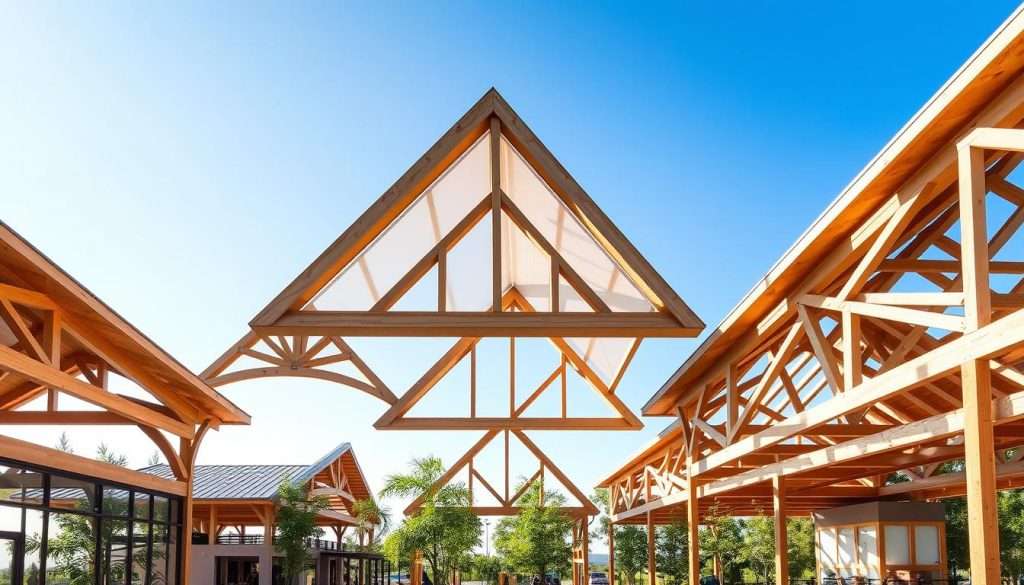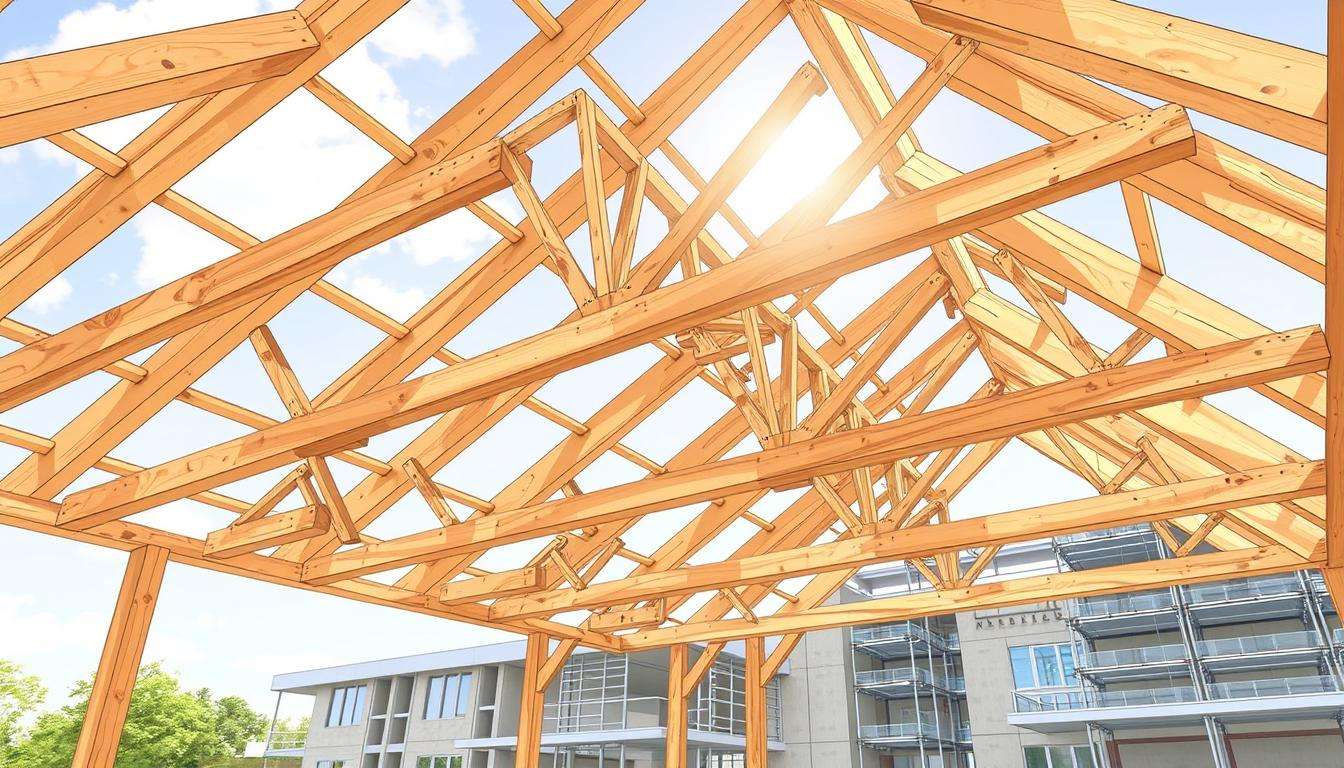What is a truss roof? Truss roof systems are a new way to build homes. They are different from old rafters. About 80% of new homes in the U.S. use them instead.
Trusses can go up to 60 feet long. That’s much farther than rafters, which only go about 30 feet. Truss roofs also save money, cutting costs by half. They are easy to put together and made in factories.
What is a Truss Roof?
Knowing what a truss roof definition is key for homeowners and builders. A truss roof is made of triangles that hold up a roof. These parts are made before they’re used in homes because they save money and are efficient.
Trusses help make more room inside without needing extra walls. This is because they carry the roof’s weight well.
Definition of a Truss Roof
Truss roofs are made of triangles, either wood or steel. They spread out the weight evenly. This design is strong and doesn’t let roofs sag.
Trusses are made to fit each home’s needs. They work with many roof styles, like gable and hip.
Importance in Construction
Truss roofs are very important today. They let homes have open spaces. This is because you can change walls without hurting the roof’s strength.
Knowing about truss roof types helps pick the best one for a project. Using a truss roof has many truss roof advantages. These include being easy to put up, saving time, and following building rules.
Common Types of Truss Roofs
- King Post Truss: Good for small homes, spans up to 8 meters.
- Howe Truss: Covers a wide area from 6 to 30 meters.
- Pratt Truss: The oldest and cheapest, spans 20 to 30 meters, often in industrial buildings.
- Fan Truss: Usually made of steel, spans 10 to 15 meters.
- Scissor Truss: Mainly in churches and cathedrals, has crossed bottom chord posts.
- Fink Truss: Common in homes for its good load spreading.

Picking the right truss roof type brings big benefits. It lets you design more freely and makes the structure stronger. Talking to a skilled carpenter or builder is smart. They make sure the roof fits your project perfectly.
Advantages of Truss Roof Systems
Truss roof systems have many benefits for homes and businesses. They help save money and make building easier. Let’s look at why truss roofs are great.
Enhanced Structural Integrity
Truss roofs make buildings stronger. They spread weight evenly, so walls don’t get too much pressure. This lets homes have big, open spaces that people love today.
Cost-Effectiveness
Truss roofs are cheaper than building walls. They cost 30-50% less. Factories make them fast, so buildings go up quicker. This saves money on labor and waste.
Design Flexibility
Truss roofs can be shaped in many ways. New tech lets builders make cool designs like fancy ceilings. Because they’re made in factories, they don’t warp, making them better quality.

| Benefits | Details |
|---|---|
| Cost Efficiency | 30-50% less than traditional framing. |
| Time-Saving | Installation can take as little as a few hours. |
| Design Versatility | Supports complex designs and longer spans. |
| Quality Control | Manufactured under consistent conditions to prevent warping. |
| Reduced Waste | Streamlined process minimizes material waste. |
Components of a Truss Roof
It’s important to know about truss roof parts. Each part helps the roof last longer and stay strong. We’ll look at the main parts, what they’re made of, and why engineering is key.
Key Elements of Trusses
Truss roofs have important parts that make them strong and efficient. These parts are:
- Collar Tie: A beam that connects two rafters near the top, making the roof stable.
- Strutting Beam: A beam that helps carry roof loads to the walls.
- Top Plate: Supports rafters and connects to wall studs.
- King Post: A central post in king post roofs, adding support.
- Queen Post: Two vertical posts in lighter roofs, making them stable.
Materials Used in Construction
The materials used in truss roofs matter a lot. They affect how strong and good the roof is. Common materials are:
- Wood: Durable and easy to put up.
- Steel: Very strong for big spans.
- Engineered Wood Products: Mixes wood’s look with better strength.
Different materials can be chosen based on engineering needs and where the roof is.
Role of Engineering in Design
Engineering truss roof design is key for a good roof. It makes sure all parts work well together. The design process includes:
- Load Analysis: Checks the loads the roof will face, like wind and snow.
- Structural Integrity Assessment: Makes sure each part can handle its load.
- Bracing Configuration: Uses bracing to keep the roof steady and in shape.
Good engineering helps avoid problems like the roof bending or breaking. For more on truss roofs, check out this resource.
Installation Process of Truss Roofs
Starting a truss roof project can feel hard. But knowing the steps makes it easier. Good planning and knowing possible problems help a lot.
Preliminary Planning Steps
First, you need to plan well. Here are key steps:
- Site Assessment: Check if the site is good for the roof.
- Building Design: Make sure the roof fits the building’s design.
- Load Considerations: Figure out how much weight the roof can hold.
- Permitting Process: Get the needed permits to follow rules.
Installation Techniques
After planning, it’s time to start installing. Here’s what to do:
- Delivery and Placement: Put the trusses on the wall plates carefully. They should be about 2 feet apart.
- Securing Trusses: Make sure the trusses are well attached.
- Bracing: Add bracing to make the roof stable.
- Complete Inspection: Check the roof to make sure it’s up to standard.
Common Challenges and Solutions
Some problems might come up during installation:
- Weather Conditions: Bad weather can slow things down. Plan for it.
- Misalignment: Place the trusses right. Use tools to help.
- Inspection Compliance: Follow local rules. Get help from experts.
- Site Accessibility: Make the site easy to get to. Clear it before starting.
Knowing the installation steps and possible problems helps a lot. Follow these tips for a strong and safe roof.
Maintenance and Longevity of Truss Roofs
To keep your truss roof strong, regular care is key. Check it often for damage, moisture, or wear. Do these checks twice a year, especially after bad weather.
This helps your roof last longer. Watch for cracks, warps, or mold. These signs mean you need to fix things fast.
Routine Inspection Practices
Checking your truss roof means looking at everything. This includes connectors, supports, and insulation. Make sure the attic has good air flow and insulation to stop moisture.
Regular checks can save you money. They catch small problems before they get big.
Repairing and Upgrading Trusses
If you find damage, fix it right away. Upgrading trusses makes them stronger and more energy-efficient. Always get help from a pro to make sure it’s done right.
Factors Impacting Lifespan
Many things can shorten a truss roof’s life. Wind, temperature changes, and snow can all affect it. In areas with lots of storms, trusses are made to handle strong winds.
Knowing these factors helps you plan better. This way, you can keep your roof in good shape. It will protect your home and give you peace of mind.
